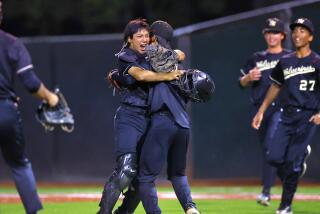College Baseball / Bob Cuomo : NCAA Rule Change a Bit Water-Logged
- Share via
The NCAA had good intentions when it imposed schedule limitations on Division I baseball teams, effective this season.
Under the plan, schools are limited to 80 games a year, with a maximum of 60 to be played in the spring. Conference playoffs and NCAA tournament games don’t count against the total. A team may then play 20 exhibition games during its fall practice period.
The cutback was made to reduce travel expenses and to lessen the amount of class time players have to miss.
But the NCAA apparently failed to take weather into account. This is only the third week of the season, and the schedules of several Southland teams already have been reduced because of recent rains.
USC, Cal State Long Beach and UC Irvine have had four games canceled. Pepperdine has lost three games, including last Sunday’s home date with USC. Cal State Fullerton was in Tucson playing Arizona last weekend, but its season-opening, three-game series at Stanford was rained out.
Almost every coach contacted by The Times is in favor of the schedule limitations, the notable exception being USC’s Rod Dedeaux.
“I’m very strongly opposed to it,” Dedeaux said. “The people who are for it (the NCAA) mean well, but they don’t understand the situation. Baseball is a game played outdoors. . . . There’s a weather factor. You can’t reschedule rainouts late in the season when you have conference games to play.”
As for the welfare of the student-athlete, Dedeaux said: “Say you have (nonconference) games on Tuesday and Wednesday. If a player has a class Tuesday, he can play Wednesday. Now, if there’s no game Wednesday, he’ll probably find a way to miss the Tuesday class so he can play.”
Other coaches’ opinions:
--UCLA’s Gary Adams: “I’m in favor of (the restriction). I would have been happier if the number (of spring games) was 65 or 70, but not more than 70. We are dealing with students, after all. I wouldn’t want them to miss too much class time.
“I’m not too upset with the 60-game limit, but I’m not able to schedule games with teams I’ve always played--Occidental, Cal Lutheran, Southern California College, because of the cutback.”
--Arizona State’s Jim Brock: “I think it’s a good thing. It had to come down sooner or later. I think it’s reasonable to play 60 games in the spring. It addresses the problem.
“Anytime you have a situation when schools can schedule an unlimited number of games, it gives those schools a recruiting advantage. A kid thinks that if he plays more, it can help him get more exposure and better stats.
“This will put more emphasis on fall programs. You can play meaningful games and generate interest in your team.”
--Fullerton’s Augie Garrido: “I’d rather not have any limitations, but if we have to cut back, 60 is a good number. I can accept that. If we cut out the games against Division II teams and others (NAIA schools), we can get down to 60. . . . It’s going to hurt the Riverside tournament. That’s seven games you’d have to play. We won’t play in it.”
--Pepperdine’s Dave Gorrie: “It’s not good to have someone say that this is the way it’s going to be. But in a way, it’s better. . . . It’s not going to affect us that much, because we don’t play many more than that (63 in 1985) because of our academic requirements.”
--Loyola Marymount’s Dave Snow: “I think it’s a good idea, especially for a school like Loyola, which is academically oriented. It’s a big burden for players to do both (study and play). As coaches, we tend to overplay (schedule a lot of games), and that’s not good. It won’t affect Loyola, because we don’t play more than that (55 in 1985).”
Adams said there was another reason for the schedule restrictions. “What hurt us, and what probably caused this, is that some teams got carried away and played too many games.”
He was alluding to such schools as San Diego State and Wichita State which have, on occasion, played considerably more than 80 games.
San Diego State set an NCAA record in 1982 by playing 91 games, 85 during the regular season. The Aztecs played 89 games in 1984, 80 in the regular season. Wichita State played 87 games in 1982, 79 of them in the regular season. In 1984, Fullerton played 86 games, 76 in the regular season.
Gorrie pointed out another benefit to having teams play a like number of games. “It’s going to have a good effect on statistics,” he said. “Now we can really determine the stat leaders and records. In 1982, we stole a lot of bases (271 in 67 games), but Wichita State played many more games, and so they had more stolen bases (333, an NCAA record).”
Baseball Notes The original schedule-restricting proposition, approved at the 1985 NCAA convention, had Division II schools playing a total of 60 games the entire year. But at this year’s convention, held last month in New Orleans, Division II teams were allowed to schedule the same number of games--60 spring, 20 fall--as the Division I schools. The vote was close, though, 74-69. . . . Loyola Marymount, which lost its first six games last season, is off at 9-1 this time around. The Lions won their first eight games before losing the opener of a double header to Arizona State last Saturday in Tempe, 9-7. The Lions won the first game of the series Friday, 10-2, behind the strong pitching of Tim Layana. In raising his record to 3-0, the senior right-hander allowed just four singles and a double while striking out 10. . . . Rick Morris, Arizona State center fielder, hit his seventh and eighth home runs Monday in the Sun Devils’ 15th game, a 14-13 win over UC Riverside. Last season he hit 16 homers in 65 games. . . . ASU Coach Jim Brock said that shortstop Mike Benjamin, a transfer from Cerritos College, is one of the best the school has had. “Benjamin has been totally pleasing at shortstop,” he said. “He’s one of the best at setting up what we want to do. He has good range and gets a quick jump on the baseball.”
More to Read
Go beyond the scoreboard
Get the latest on L.A.'s teams in the daily Sports Report newsletter.
You may occasionally receive promotional content from the Los Angeles Times.










